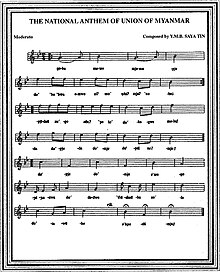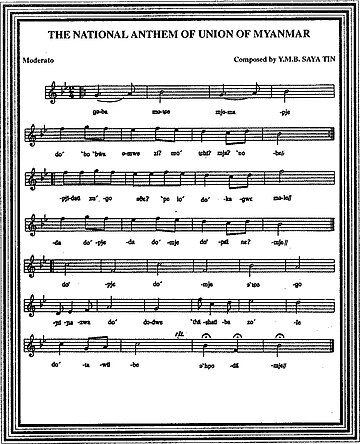The National Anthem[1] (Burmese: နိုင်ငံတော်သီချင်း; MLCTS: Nuingngamtausihkyang:; Burmese pronunciation: [nàɪɴŋàɴtɔ̀θìtɕʰɪ́ɴ]; lit. 'State Song') is the national anthem of Myanmar. It consists of two parts; the first half is a traditional Burmese style section, before transitioning into the second half, a Western-style orchestra. Because of the second half, both the "National Anthem" and its predecessor "Dobama Song" are popularly known as "Kaba Ma Kyei" (Burmese: ကမ္ဘာမကျေ; MLCTS: Ka.bha ma. kye, Burmese pronunciation: [ka̰bà ma̰ tɕè]; lit. 'Till the End of the World').[2][3]
| English: National Anthem of the Republic of the Union of Myanmar | |
|---|---|
| ပြည်ထောင်စုသမ္မတမြန်မာနိုင်ငံတော် နိုင်ငံတော်သီချင်း | |
 | |
National anthem of Myanmar | |
| Lyrics |
|
| Music | YMB Saya Tin, 1930 |
| Published |
|
| Adopted |
|
| Audio sample | |
second verse instrumental version by U.S. Navy Band | |
A long-standing tradition is that those who sing the national anthem bow at the end, as a show of respect for the nation.
History
Pre-colonial Burma did not have a proper national anthem, but had compositions glorifying the king, which served as royal anthems. After the annexation of Burma by the British Raj in 1886, "God Save the King" became the national anthem of British Burma.[4]: 98
In 1930, a musician from Mandalay named Saya Tin went to Rangoon and contacted the Thakins to write a new national anthem together. They set four criteria for the anthem: it must include the background of Burmese history; the current situation of Burma with regrets, lessons, and then encouraging words; it must agitate Burmese habits to build a new age; and the anthem must agitate national pride of any Burmese who listens to it. For these criteria to be met, many Thakins including Thakin Ba Thaung, Thakin Thein Maung, Thakin Hla Baw, Thakin Tha Do, Thakin On Pe, Thakin Kyaw Tun Sein, and Thakin Po Ni helped find words, and YMB Saya Tin wrote the lyrics originally titled "Dobama Song" (‹See Tfd›တို့ဗမာသီချင်း). Besides being the leader of the Thakins, Thakin Ba Thaung was working as a teacher of translation at Rangoon University. He had a discussion with U Tun Sein, a tutor of mathematics; U Nyunt, a tutor of Burmese; and Ko Nu, a student. On 19 July 1930, the Dobama Song was sung for the first time in a reading room of Thaton Hostel. Written in Burmese and English, it was published in the University Magazine. On 20 July 1930, it was sung with a ceremony with a huge public crowd inside U San Tun Hall at the Rahu corner of Shwedagon Pagoda. After that the Dobama Asiayone received a lot of invitations to come and sing the song. The Thakins tried to establish a tradition of singing Dobama Song in every meeting and ceremony.[5]
On 27 June 1936, the Dobama Song was declared as the national anthem of Burma at the second conference of Dobama Asiayon held in Myingyan.[6] Since then, Burmese nationalist sang Dobama Song instead of God Save the King.
The State of Burma, a Japanese puppet state, officially adopted the Dobama Song as its state anthem in 1943.[7]
In the lead up to Burma's independence, U Nu asked U Sein Mya Maung to write a national anthem for their soon-to-be independent country. U Sein Mya Maung used the Dobama Song as a template, keeping the song's melody but slightly modifying the lyrics.[8][9] The National Anthem was adopted as Burma's national anthem on 22 September 1947.[4]: 99
On 18 June 1989, the State Law and Order Restoration Council (the ruling military junta at the time) ordered to change the word ‹See Tfd›ဗမာ (ALA-LC: Bamā) to ‹See Tfd›မြန်မာ (ALA-LC: Mranʻmā) in the lyrics of the national anthem, insisting that the former refers only to Bamar people, while the latter represents all the national races.[10] In fact, both words mean either Burma (Myanmar) or Burman (Bamar people).[11]
According to the 2008 Constitution of Myanmar, the complete version of the national anthem is specified as consisting of both the traditional Burmese style and Western-style sections.[12]
Official lyrics
Post-1989 official version
Burmese lyrics
| Burmese script[13] | Romanisation | MLC Transcription System | IPA transcription as sung[b] |
|---|---|---|---|
တရားမျှတ လွတ်လပ်ခြင်းနဲ့ မသွေ၊ |
Tăyá hmyạ tạ lut lap chíng nệ mă đwè |
Ta.ra: hmya. ta. lwat lap hkrang: nai. ma. swe |
[ta̰.já m̥ja̰.ta̰ lʊʔ.laʔ t͡ɕʰɪ́ŋ nɛ̰ ma̰ θwè ǀ] |
English translation
| Official[14] | Literal |
|---|---|
Accompanied with justice and freedom; |
Where prevail justice and independence |
Historical lyrics (Dobama Song)
1930 original version
တကောင်းအဘိရာဇာ၊ တို့ဗမာ သာကီမျိုးဟာမို့ မညှိုး ဂုဏ်တေဇာ၊
ယိုးဒယားနှင့် ကုလား[d]ကိုပါ၊ တိုက်ခိုက်ကာ အောင်ခဲ့တာ တို့ဗမာ၊
စိန်မှန်ကင်းအစစ်၊ အဖြစ်ကြီးဖြစ်လျက်၊ ထင်းတလှည့် ကြုံရ၊
ထုံးနှင့်မသွေ၊ လောကဓမ္မတာပေ၊ ငါတို့ ကံခေ ဖြစ်ရပြန်သလေ၊
သို့သော် အရင်းကိုစစ်လျှင် ဗမာပြည် ငါတို့ ငါတို့ပြေ။
နောင်ဥဒါန်း ဘယ်မကြေစရာ၊ ရာဇဝင်တင်ထား မျိုးရိုးနွယ်လာ၊
ကမ္ဘာတခွင်မှာဖြင့် ဗမာအထင်အရှား တို့ခေတ်တွင်မှ ညံ့ကြတော့မှာလား
တို့ဗမာ၊ တို့ဗမာ မဟုတ်လေသလား
𝄆 တို့ဗမာ ငါတို့ဗမာ 𝄇 𝄆 ဒါ ငါတို့ဗမာ 𝄇
အားလုံး ညီညီ ယောက်ျားဘသား တို့ဗမာ
နောင်လာနောက်သား ကောင်းစားဖို့ရာ
တို့ကိုယ်ကျိုး လုံးလုံးမပါ၊
ရဲရဲဗမာပီပီ ဗမာပြေ တို့ဗမာဖို့ပါ၊
သခင်ကျင့်ကို ကျင့်ကြပါ၊ သခင်မျိုးဟေ့ တို့ဗမာ၊
မိုးအောက်မြေပြင်မှာ အထက်တန်းစိတ်နဲ့ စာမရီသွေး တို့ဗမာ။
𝄆 ကမ္ဘာမကြေ ဗမာတွေ ဒါတို့ပြေ ဒါတို့မြေ ဒါငါတို့ပြေ 𝄇
𝄆 ဒါတို့ပြေ ဒါတို့မြေ ဒါငါတို့ပြေ 𝄇
𝄆 တို့ဗမာ 𝄇 ပြေကို တိုင်းရင်းသား အကုန်အစင်၊
တို့ပြေလို့ မှတ်ထင်၊
တို့ဝတ္တရားပင် တို့ဗမာသခင်။
အမျိုးသားရေး ကြိုးပမ်းကြပါ တို့ဗမာ ဟေ့ တို့ဗမာ၊
ဪ အမျိုးသားရေး ကြိုးပမ်းကြပါ၊ တို့ဗမာ ဟေ့ တို့ဗမာ၊
အရှေ့ကနေဝန်း ထွက်သည့်ပမာပ၊
တို့ခေတ်ကိုတော့ ရောက်ရမည်မှာ မလွဲပါ၊ တို့ဗမာ ဟေ့တို့ဗမာ၊
ဗမာပြည်တဝှမ်း အကုန်၊ တို့အိမ်မှတ်ပါ၊ တို့ယာမှတ်ပါ၊ အဲဒါ တို့ဗမာ။
𝄆 ကမ္ဘာမကြေ ဗမာတွေ ဒါတို့ပြေ ဒါတို့မြေ ဒါငါတို့ပြေ 𝄇
𝄆 ဒါတို့ပြေ ဒါတို့မြေ ဒါငါတို့ပြေ 𝄇
𝄆 တို့ဗမာ 𝄇 ပြေကို တိုင်းရင်းသား အကုန်အစင်၊
တို့ပြေလို့ မှတ်ထင်၊
တို့ဝတ္တရားပင် တို့ဗမာသခင်။
Edited official version
တကောင်းအဘိရာဇာ၊ တို့ဗမာ သာကီမျိုးဟာမို့ မညှိုး ဂုဏ်တေဇာ၊
များစွာပတိုင်းများကိုပါကိုပါ၊ တိုက်ခိုက်ကာ အောင်ခဲ့တာ တို့ဗမာ၊
စိန်မှန်ကင်းအစစ်၊ အဖြစ်ကြီးဖြစ်လျက်၊ ထင်းတလှည့် ကြုံရ၊
ထုံးနှင့်မသွေ၊ လောကဓမ္မတာပေ၊ ငါတို့ ကံခေ ဖြစ်ရပြန်သလေ၊
သို့သော် အရင်းကိုစစ်လျှင် ဗမာပြည် ငါတို့ ငါတို့ပြေ။
နောင်ဥဒါန်း ဘယ်မကြေစရာ၊ ရာဇဝင်တင်ထား မျိုးရိုးနွယ်လာ၊
ကမ္ဘာတခွင်မှာဖြင့် ဗမာအထင်အရှား တို့ခေတ်တွင်မှ ညံ့ကြတော့မှာလား
တို့ဗမာ၊ တို့ဗမာ မဟုတ်လေသလား
𝄆 တို့ဗမာ ငါတို့ဗမာ 𝄇 𝄆 ဒါ ငါတို့ဗမာ 𝄇
အားလုံး ညီညီ ယောက်ျားဘသား တို့ဗမာ
နောင်လာနောက်သား ကောင်းစားဖို့ရာ
တို့ကိုယ်ကျိုး လုံးလုံးမပါ၊
ရဲရဲဗမာပီပီ ဗမာပြေ တို့ဗမာဖို့ပါ၊
သခင်ကျင့်ကို ကျင့်ကြပါ၊ သခင်မျိုးဟေ့ တို့ဗမာ၊
မိုးအောက်မြေပြင်မှာ အထက်တန်းစိတ်နဲ့ စာမရီသွေး တို့ဗမာ။
𝄆 ကမ္ဘာမကြေ ဗမာတွေ ဒါတို့ပြေ ဒါတို့မြေ ဒါငါတို့ပြေ 𝄇
𝄆 ဒါတို့ပြေ ဒါတို့မြေ ဒါငါတို့ပြေ 𝄇
𝄆 တို့ဗမာ 𝄇 ပြေကို တိုင်းရင်းသား အကုန်အစင်၊
တို့ပြေလို့ မှတ်ထင်၊
တို့ဝတ္တရားပင် တို့ဗမာသခင်။
အမျိုးသားရေး ကြိုးပမ်းကြပါ တို့ဗမာ ဟေ့ တို့ဗမာ၊
ဪ အမျိုးသားရေး ကြိုးပမ်းကြပါ၊ တို့ဗမာ ဟေ့ တို့ဗမာ၊
အရှေ့ကနေဝန်း ထွက်သည့်ပမာပ၊
တို့ခေတ်ကိုတော့ ရောက်ရမည်မှာ မလွဲပါ၊ တို့ဗမာ ဟေ့တို့ဗမာ၊
ဗမာပြည်တဝှမ်း အကုန်၊ တို့အိမ်မှတ်ပါ၊ တို့ယာမှတ်ပါ၊ အဲဒါ တို့ဗမာ။
𝄆 ကမ္ဘာမကြေ ဗမာတွေ ဒါတို့ပြေ ဒါတို့မြေ ဒါငါတို့ပြေ 𝄇
𝄆 ဒါတို့ပြေ ဒါတို့မြေ ဒါငါတို့ပြေ 𝄇
𝄆 တို့ဗမာ 𝄇 ပြေကို တိုင်းရင်းသား အကုန်အစင်၊
တို့ပြေလို့ မှတ်ထင်၊
တို့ဝတ္တရားပင် တို့ဗမာသခင်။
Historical lyrics (National Anthem)
1947 first draft
[4]: 99
| Burmese script | Romanisation (BGN/PCGN) |
|---|---|
အမျိုးသားရေး ကြိုးပမ်းစို့လေ၊ |
Amyothaye kyobanzole, |
1947 official version (1948-1989)
| Burmese script[16] | Romanisation (BGN/PCGN) |
|---|---|
တရားမျှတ လွတ်လပ်ခြင်းနဲ့ မသွေ၊ |
Tayamyhada lutlatchinnè mathwe, |
Notes
- See Help:IPA/Burmese and Burmese phonology.
References
External links
Wikiwand in your browser!
Seamless Wikipedia browsing. On steroids.
Every time you click a link to Wikipedia, Wiktionary or Wikiquote in your browser's search results, it will show the modern Wikiwand interface.
Wikiwand extension is a five stars, simple, with minimum permission required to keep your browsing private, safe and transparent.

